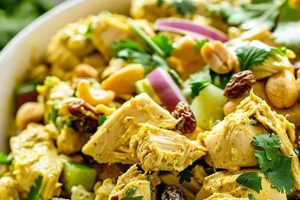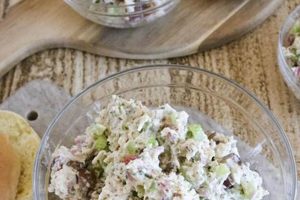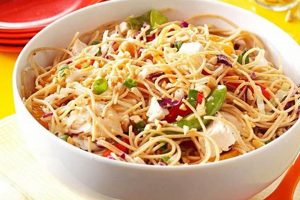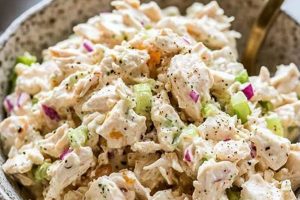A minimalist approach to a classic dish, this type of salad typically combines cooked chicken, a binding agent (such as mayonnaise or yogurt), and a flavor enhancer (like celery, grapes, or onion). Variations can substitute or augment these core components, often prioritizing simplicity and speed of preparation. For example, one could combine shredded rotisserie chicken with plain Greek yogurt and chopped grapes for a quick and healthy meal.
Streamlined recipes offer significant advantages, particularly for busy individuals or those new to cooking. They minimize shopping time, reduce food waste by focusing on a few key ingredients, and simplify the cooking process. Historically, resource scarcity and the need for quick meal preparation likely contributed to the development of such efficient recipes. This culinary efficiency translates to a practical, modern approach to cooking.
This article will delve into specific variations of these simple salads, exploring different flavor profiles, dietary adaptations, and tips for optimal preparation. It will also provide nutritional information and offer suggestions for serving and storage.
Tips for Simple Chicken Salads
Optimizing flavor and texture in a minimalist chicken salad requires attention to ingredient selection and preparation techniques. The following tips offer guidance for creating a satisfying and flavorful dish with minimal effort.
Tip 1: Choose High-Quality Chicken: The chicken is the foundation of the salad. Using pre-cooked rotisserie chicken offers convenience, while poaching or grilling fresh chicken allows for greater control over flavor and sodium content.
Tip 2: Consider the Binding Agent: Mayonnaise provides a classic creamy texture, while Greek yogurt offers a lighter, tangier alternative. Avocado can also be used for a healthy, creamy option.
Tip 3: Select Flavorful Additions: Even a single additional ingredient can significantly impact the overall flavor profile. Consider options like chopped celery, grapes, red onion, dried cranberries, or chopped apples.
Tip 4: Season Strategically: Salt and pepper are essential, but consider incorporating other seasonings like garlic powder, onion powder, paprika, or a pinch of cayenne pepper for added depth.
Tip 5: Texture Matters: Dicing ingredients uniformly creates a pleasant consistency. For a smoother salad, consider finely chopping or shredding the chicken and chosen additions.
Tip 6: Chill Before Serving: Chilling allows the flavors to meld and enhances the salad’s overall freshness. Aim for at least 30 minutes of refrigeration before serving.
Tip 7: Explore Serving Options: These salads are versatile. Enjoy them on bread, crackers, lettuce wraps, or as a standalone dish.
By following these tips, one can elevate a simple chicken salad from basic to exceptional, maximizing flavor and texture while minimizing preparation time and complexity.
With an understanding of these core principles, one can confidently explore a wide range of flavor combinations and create personalized versions of this adaptable dish.
1. Cooked Chicken
Cooked chicken serves as the foundational protein source in a 3-ingredient chicken salad recipe. Its presence is not merely incidental; it defines the dish itself. Without cooked chicken, the concept of a chicken salad becomes inherently paradoxical. The cooking process transforms raw chicken into a palatable and safe ingredient, ready to absorb flavors from the other components. Methods like poaching, grilling, baking, or rotisserie cooking influence the final salad’s taste and texture. For instance, rotisserie chicken contributes a smoky depth, while poached chicken offers a cleaner, milder flavor profile. The choice of cooking method directly impacts the overall culinary experience.
The type of cooked chicken also plays a significant role. Using shredded chicken from a whole roasted bird provides a richer, more complex flavor than using diced chicken breast. Furthermore, the texture of the cooked chicken influences the final salad’s consistency. Overcooked chicken can result in a dry, stringy salad, while perfectly cooked chicken contributes a moist, tender texture. Considering these nuances elevates the simple 3-ingredient recipe from basic sustenance to a more refined culinary creation. One practical application of this understanding involves selecting pre-cooked chicken products like rotisserie chicken to minimize preparation time without sacrificing flavor or quality.
In summary, cooked chicken’s importance in a 3-ingredient chicken salad recipe extends beyond its role as a protein source. It directly impacts flavor, texture, and overall quality. Careful consideration of cooking methods and chicken types allows for greater control over the final product. This understanding empowers individuals to create flavorful and satisfying meals with minimal effort, highlighting the practical significance of even the simplest culinary choices.
2. Binding Agent
The binding agent is the crucial component that transforms individual ingredients into a cohesive salad. Its function extends beyond simply holding the chicken and flavor enhancers together; it contributes significantly to the overall texture, flavor, and moisture content of the final dish. Understanding the role and variety of binding agents is essential for creating a successful 3-ingredient chicken salad.
- Classic Emulsions:
Mayonnaise is the quintessential binding agent for classic chicken salads. Its creamy texture and tangy flavor complement the chicken while providing a rich mouthfeel. Variations include full-fat, light, or olive oil-based mayonnaise, each offering a distinct flavor profile and calorie count. Miracle Whip, a tangier, lower-fat alternative, offers a different flavor profile that some may prefer. The choice of emulsion directly influences the salad’s richness, tanginess, and overall calorie content.
- Healthier Alternatives:
For those seeking a lighter option, Greek yogurt provides a tangy, protein-rich alternative to mayonnaise. Its lower fat content and higher protein content contribute to a healthier profile. Avocado, blended into a smooth paste, offers another healthy and flavorful alternative, contributing a creamy texture and subtle, nutty flavor. These alternatives offer health benefits without significantly compromising the salad’s overall texture and enjoyment.
- Flavorful Enhancements:
While primarily serving as a binder, some options also contribute to the overall flavor profile. For example, flavored mayonnaise, such as chipotle or roasted garlic, can infuse the salad with additional complexity. Similarly, incorporating herbs or spices into plain Greek yogurt can further enhance the salad’s flavor dimensions. These additions demonstrate the potential for the binding agent to serve a dual purpose, simplifying the recipe while amplifying its flavor.
- Quantity Considerations:
The amount of binding agent used directly influences the final salad’s consistency. Too little can result in a dry, crumbly salad, while too much can create a salad that is overly wet and lacks textural integrity. Achieving the desired consistency requires careful consideration of the chosen binding agent and personal preference. A good starting point is to add the binding agent gradually, mixing thoroughly and adjusting until the desired consistency is reached.
The binding agent is integral to the success of a 3-ingredient chicken salad. It contributes to texture, flavor, and overall palatability. Understanding the diverse options and their respective characteristics allows for customization and optimization of this simple yet versatile dish. Choosing the right binding agent, considering its properties, and using the correct amount elevates the 3-ingredient chicken salad from a basic combination to a carefully constructed and flavorful meal.
3. Flavor Enhancer
The flavor enhancer in a 3-ingredient chicken salad recipe represents the critical element that elevates the dish beyond a simple combination of protein and binder. This component provides depth, complexity, and character, transforming a basic chicken salad into a more nuanced and satisfying culinary experience. Its presence is not merely an optional addition; it is the defining factor that distinguishes one 3-ingredient chicken salad from another. The interplay between the flavor enhancer and the other two componentscooked chicken and binding agentcreates a synergistic effect where the whole becomes greater than the sum of its parts.
Several factors dictate the effectiveness of a flavor enhancer. Firstly, its inherent flavor profile must complement the existing flavors of the chicken and binding agent. For instance, the crisp, clean taste of celery harmonizes well with the richness of mayonnaise and the neutrality of chicken, while the sweetness of grapes adds a contrasting dimension. Secondly, the texture of the flavor enhancer contributes to the overall sensory experience. The crunch of chopped walnuts or water chestnuts provides textural contrast to the creamy base, while the soft texture of dried cranberries offers a different kind of counterpoint. Thirdly, the quantity of the flavor enhancer must be carefully considered. Too much can overwhelm the other flavors, while too little may render its presence insignificant. Striking the right balance is crucial for achieving a harmonious flavor profile.
Practical applications of this understanding are numerous. Consider the combination of shredded rotisserie chicken, plain Greek yogurt, and chopped fresh dill. The dill, in this instance, serves as the flavor enhancer, imparting its bright, herbaceous notes to the otherwise relatively bland combination of chicken and yogurt. Alternatively, using curry powder as the flavor enhancer in a chicken salad made with mayonnaise and poached chicken creates a completely different flavor profile, showcasing the versatility of this approach. Recognizing the importance of the flavor enhancer empowers individuals to create customized variations tailored to individual preferences and dietary needs. The ability to manipulate this single element allows for a wide spectrum of flavor possibilities within the constraints of the 3-ingredient framework. Ultimately, the judicious selection and application of a flavor enhancer transforms the 3-ingredient chicken salad from a utilitarian dish into a culinary expression of creativity and personal taste.
4. Minimal Preparation
Minimal preparation is intrinsically linked to the concept of a 3-ingredient chicken salad recipe. The inherent value proposition of such a recipe hinges on its speed and ease of assembly. This efficiency stems directly from the reduced number of components and the minimized processing they require. Cause and effect are clearly delineated: fewer ingredients translate to less chopping, mixing, and measuring, resulting in a significantly shorter preparation time. This characteristic is particularly appealing to individuals with busy schedules, limited culinary experience, or a preference for streamlined cooking processes. A practical example illustrates this connection: combining pre-cooked rotisserie chicken with store-bought mayonnaise and a single chopped ingredient, such as celery, requires minimal active preparation time, making it an ideal option for a quick lunch or snack.
The importance of minimal preparation as a defining characteristic of this recipe type cannot be overstated. It represents a core benefit that distinguishes it from more complex and time-consuming salad variations. This simplicity broadens the recipe’s accessibility, allowing even novice cooks to achieve consistent and satisfying results. Furthermore, the reduced preparation time minimizes the likelihood of errors, contributing to a higher success rate. For instance, using pre-washed and pre-cut celery further streamlines the process, reducing the steps involved and further minimizing the potential for culinary mishaps. This focus on efficiency also contributes to reduced kitchen cleanup, another practical advantage that adds to the overall appeal of minimalist cooking.
In summary, minimal preparation is not merely a desirable attribute of a 3-ingredient chicken salad recipe; it is a defining characteristic that underscores its inherent value. The direct correlation between fewer ingredients and reduced preparation time offers significant practical benefits, including increased accessibility, enhanced efficiency, and a higher likelihood of culinary success. Understanding this connection empowers individuals to leverage the simplicity and convenience of these recipes, contributing to a more efficient and enjoyable cooking experience.
5. Versatile Serving
Versatility in serving options significantly enhances the practicality and appeal of a 3-ingredient chicken salad recipe. This adaptability stems from the salad’s inherent simplicity and its ability to complement a wide range of accompanying ingredients and serving vessels. The minimalist nature of the recipe allows the chicken salad to function as a blank canvas, readily adapting to various culinary contexts. Cause and effect are evident: a simple base recipe enables diverse applications, increasing mealtime flexibility. This versatility translates to greater convenience, reduced meal planning stress, and minimized food waste.
Consider the classic example of serving chicken salad on bread. Whether used in a sandwich, a wrap, or an open-faced preparation, the chicken salad readily conforms to the chosen format. This adaptability extends beyond bread-based options. Chicken salad can serve as a filling for lettuce cups, a topping for crackers or crudits, or a component within a larger salad composition. Furthermore, it can be served as a standalone dish, accompanied by a simple side salad or a portion of fruit. These diverse applications demonstrate the inherent versatility of the 3-ingredient chicken salad recipe, transforming it from a single-use dish into a multifaceted culinary tool.
The practical significance of this versatility is substantial. It allows individuals to repurpose leftover chicken or utilize readily available ingredients to create a variety of meals. This adaptability reduces the need for extensive meal planning and minimizes the likelihood of culinary boredom. Furthermore, the ability to incorporate the chicken salad into different serving formats caters to a wider range of dietary preferences and restrictions. Understanding the versatility of this simple recipe empowers individuals to maximize its utility, contributing to a more efficient and adaptable approach to meal preparation. This adaptability ultimately elevates the 3-ingredient chicken salad from a basic dish to a versatile and valuable component of a flexible and efficient culinary repertoire.
Frequently Asked Questions
This section addresses common inquiries regarding 3-ingredient chicken salad recipes, providing concise and informative responses to facilitate understanding and practical application.
Question 1: Can canned chicken be used in these recipes?
Canned chicken can be used, but its texture and flavor profile differ from freshly cooked or rotisserie chicken. Draining the canned chicken thoroughly is essential to prevent excess moisture in the final salad.
Question 2: How long can the prepared salad be stored?
Refrigerated storage in an airtight container is recommended for up to 3-4 days. Quality may degrade beyond this timeframe.
Question 3: Are there vegan alternatives for this type of recipe?
Chickpea salad or jackfruit salad can offer similar flavor profiles and textures using plant-based protein sources and vegan mayonnaise or yogurt alternatives.
Question 4: How can one adjust the recipe for specific dietary needs, such as low-sodium or gluten-free?
Selecting low-sodium ingredients, such as homemade chicken broth and low-sodium mayonnaise, helps control sodium content. Ensuring all added ingredients are gluten-free addresses gluten-free dietary requirements.
Question 5: What are some strategies for enhancing the flavor complexity of a simple recipe?
Incorporating spices, herbs, or a small amount of a flavorful ingredient like chopped onion or a dash of hot sauce can add depth without significantly increasing complexity.
Question 6: Can these recipes be scaled up for larger gatherings or meal prepping?
Recipes can be easily scaled by proportionally increasing ingredient quantities. Storage in individual portions facilitates meal preparation.
Understanding these frequently asked questions provides a comprehensive foundation for creating and enjoying simple yet satisfying chicken salads.
The following section provides a collection of example recipes demonstrating the principles discussed throughout this article.
3 Ingredient Chicken Salad Recipe
This exploration of the 3-ingredient chicken salad recipe has highlighted its core componentscooked chicken, binding agent, and flavor enhancerand their synergistic interplay. Minimal preparation and versatile serving options contribute to the recipe’s practicality and adaptability. Understanding the nuances of each component empowers culinary experimentation within a streamlined framework. From ingredient selection to serving suggestions, informed choices elevate this simple concept beyond basic sustenance.
The enduring appeal of the 3-ingredient chicken salad recipe lies in its balance of simplicity and adaptability. Its efficiency caters to modern lifestyles, while its versatility allows for personalized culinary expression. This fundamental recipe structure offers a foundation for continued exploration and adaptation, demonstrating that culinary complexity is not a prerequisite for flavorful and satisfying meals.






